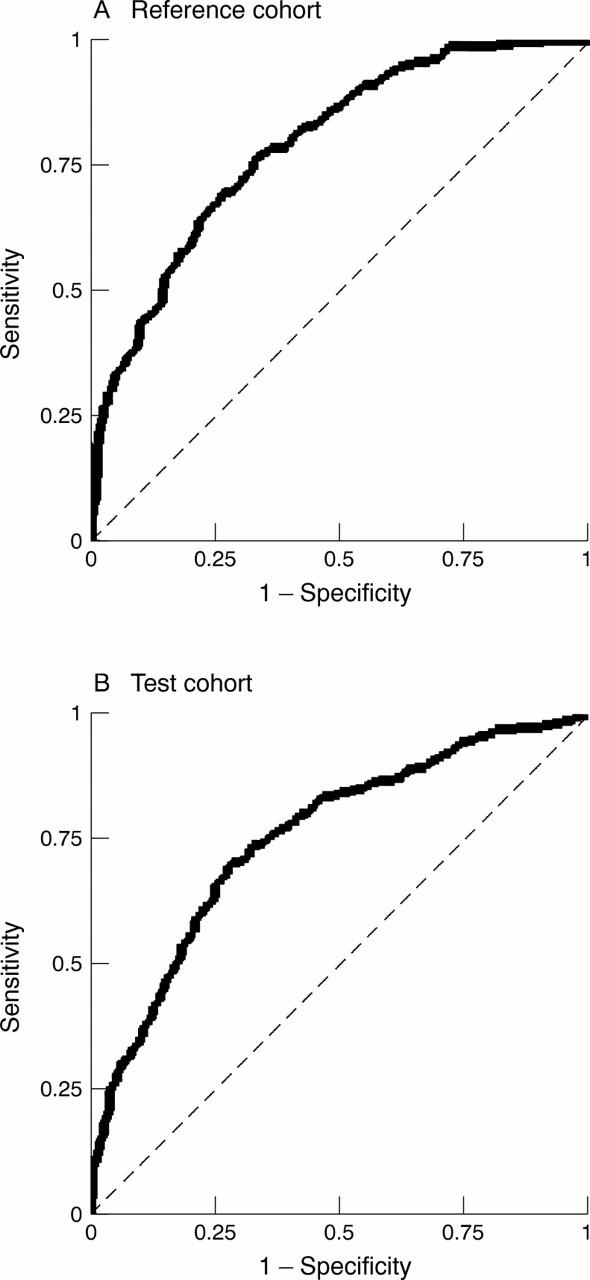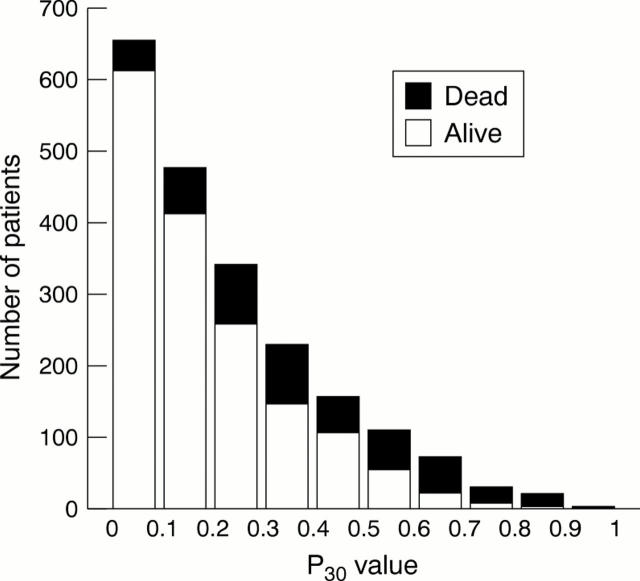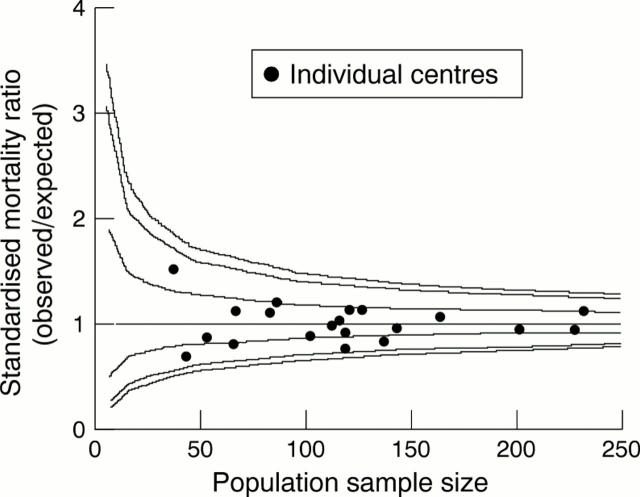Abstract
OBJECTIVE—To develop a simple risk model as a basis for evaluating care of patients admitted with acute myocardial infarction. METHODS—From coronary care registers, biochemistry records and hospital management systems, 2153 consecutive patients with confirmed acute myocardial infarction were identified. With 30 day all cause mortality as the end point, a multivariable logistic regression model of risk was constructed and validated in independent patient cohorts. The areas under receiver operating characteristic curves were calculated as an assessment of sensitivity and specificity. The model was reapplied to a number of commonly studied subgroups for further assessment of robustness. RESULTS—A three variable model was developed based on age, heart rate, and systolic blood pressure on admission. This produced an individual probability of death by 30 days (P30) where P30 = 1/(1 + exp(−L30)) and L30 = −5.624 + (0.085 × age) + (0.014 × heart rate) − (0.022 × systolic blood pressure). The areas under the receiver operating characteristic curves for the reference and test cohorts were 0.79 (95% CI 0.76 to 0.82) and 0.76 (95% CI 0.72 to 0.79), respectively. To aid application of the model to routine clinical audit, a normogram relating observed mortality and sample size to the likelihood of a significant deviation from the expected 30 day mortality rate was constructed. CONCLUSIONS—This risk model is simple, reproducible, and permits quality of care of acute myocardial infarction patients to be reliably evaluated both within and between centres. Keywords: acute myocardial infarction; risk model
Full Text
The Full Text of this article is available as a PDF (141.9 KB).
Figure 1 .

Receiver operating characteristic curves of sensitivity versus 1−specificity for the three variable risk model for the reference and test cohorts. The areas under these curves are 0.79 and 0.76, respectively. This model is based on admission characteristics of age, systolic blood pressure, and heart rate.
Figure 2 .
Patient numbers and outcome for the whole cohort, arranged into 10 groups according to the calculated probability of death at 30 days (P30 value).
Figure 3 .
Normogram relating the standardised mortality ratio (SMR) and sample size of each participating centre to the likelihood of significant deviation from the expected 30 day mortality rate. The 50%, 10%, and 5% significance levels beyond which the SMR is statistically different from the mean have been calculated.
Selected References
These references are in PubMed. This may not be the complete list of references from this article.
- Altman D. G., Royston P. What do we mean by validating a prognostic model? Stat Med. 2000 Feb 29;19(4):453–473. doi: 10.1002/(sici)1097-0258(20000229)19:4<453::aid-sim350>3.0.co;2-5. [DOI] [PubMed] [Google Scholar]
- Birkhead J. S. Responding to the requirements of the national service framework for coronary disease: a core data set for myocardial infarction. Heart. 2000 Aug;84(2):116–117. doi: 10.1136/heart.84.2.116. [DOI] [PMC free article] [PubMed] [Google Scholar]
- Collinson J., Flather M. D., Fox K. A., Findlay I., Rodrigues E., Dooley P., Ludman P., Adgey J., Bowker T. J., Mattu R. Clinical outcomes, risk stratification and practice patterns of unstable angina and myocardial infarction without ST elevation: Prospective Registry of Acute Ischaemic Syndromes in the UK (PRAIS-UK) Eur Heart J. 2000 Sep;21(17):1450–1457. doi: 10.1053/euhj.1999.1995. [DOI] [PubMed] [Google Scholar]
- Gheno G., Libardoni M., Zeppellini R., Cucchini F. C-reactive protein on admission as a predictor of in-hospital death in the elderly with acute myocardial infarction. Cardiologia. 1999 Dec;44(12):1023–1028. [PubMed] [Google Scholar]
- Hanley J. A., McNeil B. J. The meaning and use of the area under a receiver operating characteristic (ROC) curve. Radiology. 1982 Apr;143(1):29–36. doi: 10.1148/radiology.143.1.7063747. [DOI] [PubMed] [Google Scholar]
- Iezzoni L. I., Ash A. S., Coffman G. A., Moskowitz M. A. Predicting in-hospital mortality. A comparison of severity measurement approaches. Med Care. 1992 Apr;30(4):347–359. doi: 10.1097/00005650-199204000-00005. [DOI] [PubMed] [Google Scholar]
- Iezzoni L. I., Ash A. S., Shwartz M., Daley J., Hughes J. S., Mackiernan Y. D. Judging hospitals by severity-adjusted mortality rates: the influence of the severity-adjustment method. Am J Public Health. 1996 Oct;86(10):1379–1387. doi: 10.2105/ajph.86.10.1379. [DOI] [PMC free article] [PubMed] [Google Scholar]
- Jollis J. G., Romano P. S. Pennsylvania's Focus on Heart Attack--grading the scorecard. N Engl J Med. 1998 Apr 2;338(14):983–987. doi: 10.1056/NEJM199804023381410. [DOI] [PubMed] [Google Scholar]
- Krumholz H. M., Chen J., Wang Y., Radford M. J., Chen Y. T., Marciniak T. A. Comparing AMI mortality among hospitals in patients 65 years of age and older: evaluating methods of risk adjustment. Circulation. 1999 Jun 15;99(23):2986–2992. doi: 10.1161/01.cir.99.23.2986. [DOI] [PubMed] [Google Scholar]
- Lee K. L., Woodlief L. H., Topol E. J., Weaver W. D., Betriu A., Col J., Simoons M., Aylward P., Van de Werf F., Califf R. M. Predictors of 30-day mortality in the era of reperfusion for acute myocardial infarction. Results from an international trial of 41,021 patients. GUSTO-I Investigators. Circulation. 1995 Mar 15;91(6):1659–1668. doi: 10.1161/01.cir.91.6.1659. [DOI] [PubMed] [Google Scholar]
- Leyland A. H., Boddy F. A. League tables and acute myocardial infarction. Lancet. 1998 Feb 21;351(9102):555–558. doi: 10.1016/S0140-6736(97)09362-8. [DOI] [PubMed] [Google Scholar]
- Marshall E. C., Spiegelhalter D. J. Reliability of league tables of in vitro fertilisation clinics: retrospective analysis of live birth rates. BMJ. 1998 Jun 6;316(7146):1701–1705. doi: 10.1136/bmj.316.7146.1701. [DOI] [PMC free article] [PubMed] [Google Scholar]
- Morris J. A., Gardner M. J. Calculating confidence intervals for relative risks (odds ratios) and standardised ratios and rates. Br Med J (Clin Res Ed) 1988 May 7;296(6632):1313–1316. doi: 10.1136/bmj.296.6632.1313. [DOI] [PMC free article] [PubMed] [Google Scholar]
- Muller D. W., Topol E. J., Ellis S. G., Sigmon K. N., Lee K., Califf R. M. Multivessel coronary artery disease: a key predictor of short-term prognosis after reperfusion therapy for acute myocardial infarction. Thrombolysis and Angioplasty in Myocardial Infarction (TAMI) Study Group. Am Heart J. 1991 Apr;121(4 Pt 1):1042–1049. doi: 10.1016/0002-8703(91)90661-z. [DOI] [PubMed] [Google Scholar]
- Normand S. T., Glickman M. E., Sharma R. G., McNeil B. J. Using admission characteristics to predict short-term mortality from myocardial infarction in elderly patients. Results from the Cooperative Cardiovascular Project. JAMA. 1996 May 1;275(17):1322–1328. [PubMed] [Google Scholar]
- Purcell I. F., Newall N., Farrer M. Change in ST segment elevation 60 minutes after thrombolytic initiation predicts clinical outcome as accurately as later electrocardiographic changes. Heart. 1997 Nov;78(5):465–471. doi: 10.1136/hrt.78.5.465. [DOI] [PMC free article] [PubMed] [Google Scholar]
- Stark J., Gallivan S., Lovegrove J., Hamilton J. R., Monro J. L., Pollock J. C., Watterson K. G. Mortality rates after surgery for congenital heart defects in children and surgeons' performance. Lancet. 2000 Mar 18;355(9208):1004–1007. doi: 10.1016/s0140-6736(00)90001-1. [DOI] [PubMed] [Google Scholar]




